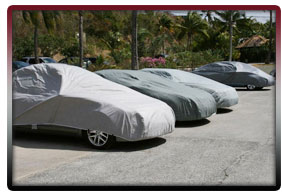Test de température intérieure

Le vent et les précipitations représentent des menaces évidentes pour une voiture, mais les rayons UV invisibles du soleil peuvent être tout aussi dévastateurs. De la décoloration des tissus d'ameublement et de la peinture à la déformation du cuir et du vinyle, la lumière du soleil et la chaleur excessives causent des dommages considérables au fil du temps. C'est pourquoi il est important de choisir une housse de véhicule qui offre une couche de protection isolante, ce qui a l'avantage supplémentaire de garder l'intérieur de la voiture au frais et confortable.
Bien que cela semble particulièrement adapté dans les régions aux températures extrêmes en été, le fait est que même des températures relativement douces peuvent produire des températures supérieures à 100 degrés Farenheit à l'intérieur d'un véhicule. Cela est dû à l’accumulation de chaleur connue sous le nom d'effet de serre : le rayonnement du soleil pénètre dans le véhicule, est absorbé par les surfaces non réfléchissantes, rayonne à partir de ces surfaces et ne peut pas facilement s'échapper de l'intérieur pour retourner dans l'atmosphère.
Ce phénomène explique des désagréments comme les boucles de ceinture de sécurité brûlantes ou les lunettes de soleil brûlantes laissées sur le tableau de bord. Mais cela explique également les reportages que nous entendons chaque été sur les enfants et les animaux domestiques qui souffrent d'un coup de chaleur ou pire après avoir été laissés dans la voiture, même pendant seulement 10 minutes. Ce n'est pas étonnant - avec une température extérieure de 90 degrés Farenheit, après seulement 10 minutes en plein soleil, l'intérieur d'une voiture peut atteindre 109 degrés Farenheit. Après 20 minutes, il atteint 119 degrés, et après 90 minutes, il atteint un stupéfiant 138 degrés - plus chaud que la température de surface la plus chaude jamais enregistrée sur Terre.
Pour s'assurer que nous offrons les meilleurs produits disponibles, l’équipe de recherche et développement d’EmpireCovers teste rigoureusement nos produits avant de lancer la production commerciale. Nous avons donc conçu un test de Température Intérieure qui nous permet de quantifier systématiquement la protection thermique offerte par les différentes housses de voiture.
Méthodologie

Nous avons testé les propriétés isolantes de quatre housses de voiture différentes : la housse de base d'intérieur, la housse de base d'extérieur, la Titan à 4 couches et la Titan à 5 couches. Ces housses ont été testées et comparées à une voiture de couleur claire non couverte, une voiture de couleur sombre non couverte et un réflecteur monté sur pare-brise.
Notre méthode a consisté à garer côte à côte quatre véhicules identiques dans un parking vide et à les orienter dans la même direction, de sorte qu'ils soient le plus près possible l’un de l’autre sans projeter d'ombre sur les autres véhicules. Nous avons ensuite équipé chaque véhicule de boîtiers de capteurs de température et d'humidité fabriqués sur mesure que nous avons placés directement sous l'appui-tête avant. Cette position a été choisie car elle était au milieu de la cabine et était suffisamment haute pour éviter l'exposition directe au soleil, ce qui aurait pu fausser les données. Chaque boîtier de température transmettait ses données toutes les 10 secondes à un récepteur sans fil et à une clé USB spécialement conçus.
Pour enregistrer les conditions ambiantes, nous avons construit un boîtier contenant des capteurs pour mesurer la température, l'humidité et la lumière. Le boîtier a été placé à l'ombre et le capteur de lumière a été collé avec du ruban adhésif à une plaque de poids et placé au soleil. Cela a été particulièrement utile pour mesurer la quantité de soleil que les véhicules ont reçue, ainsi que pour comparer les données sur plusieurs jours.

Une fois équipées de tout l'équipement d'enregistrement, les voitures ont été couvertes et laissées à la lumière directe du soleil pendant 12 heures, avant le lever du soleil jusqu’à après le coucher du soleil. Nous avons continuellement surveillé et enregistré la température intérieure de tous les véhicules, et dans cette période de temps, les housses de voiture n'ont jamais été retirées et les voitures n'ont jamais été ouvertes.
Ce processus a été répété pendant plusieurs jours. En combinant les données sur les conditions ambiantes avec les données de l'intérieur des voitures testées, notre équipe a pu déterminer un facteur de réduction de température normalisé pour toutes les voitures utilisées dans les tests.
Résultats de test
Comme on pouvait probablement s'y attendre, les températures intérieures étaient plus basses pour les voitures recouverte d’une housse, indépendamment du type de housse. Cependant, la quantité par laquelle chaque housse réduisait la température intérieure de la voiture était positivement corrélée à l'épaisseur et à la couleur du tissu : plus la housse était épaisse et légère, plus ses performances étaient bonnes.
Le moins performant de tous les dispositifs réfléchissants et de toutes les housses était le réflecteur monté sur le pare-brise, qui n'a abaissé la température intérieure que d'un facteur de 6,11 degrés Fahrenheit. Les raisons en sont la minceur du réflecteur, l'incapacité du réflecteur à couvrir toutes les vitres et le fait que le réflecteur de pare-brise se trouve à l'intérieur de la voiture, ce qui laisse le soleil pénétrer à l'intérieur de la voiture.
Parmi les housses testées, la Titan à 5 couches et la Titan à 4 couches ont généralement donné les meilleurs résultats, mais même nos options les plus économiques ont considérablement abaissé la température de la voiture par rapport à une absence totale de housse.

Résumé
En résumé, les réflecteurs de pare-brise offrent des avantages négligeables en matière de refroidissement de l'intérieur d'une voiture ou de protection contre les rayons UV nocifs. De tels réflecteurs n’ont aucune utilité, même par rapport aux housses de voiture les plus basiques disponibles. Mais les propriétaires de voitures soucieux de protéger leur investissement devraient investir dans des housses de voiture EmpireCovers haut de gamme et de haute qualité qui ont scientifiquement démontré qu’elles peuvent réduire considérablement la température intérieure de votre véhicule.
En savoir plus sur la façon dont nos housses protègent contre d'autres éléments nocifs.

